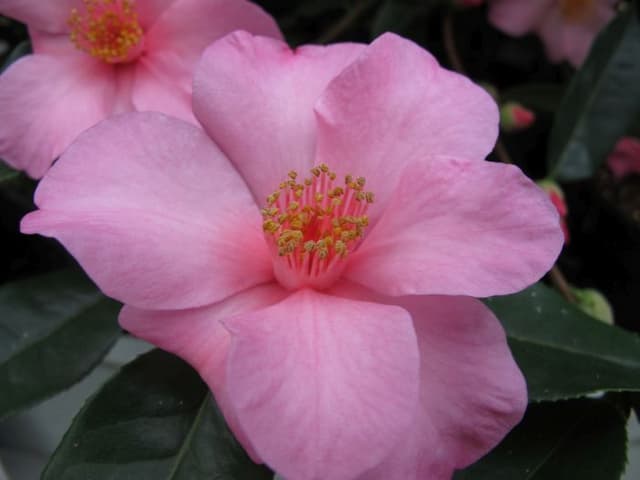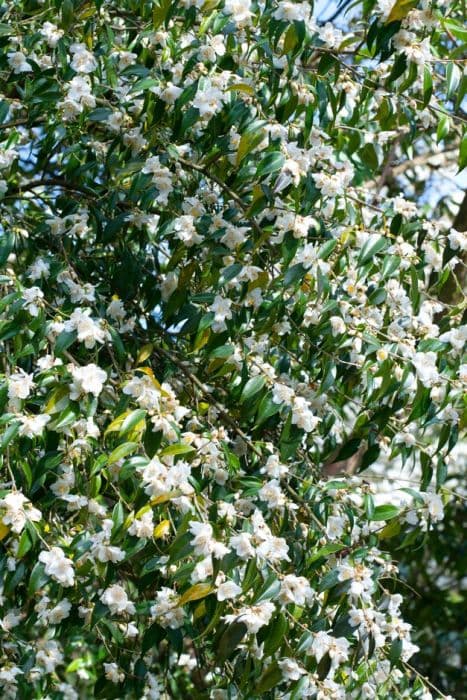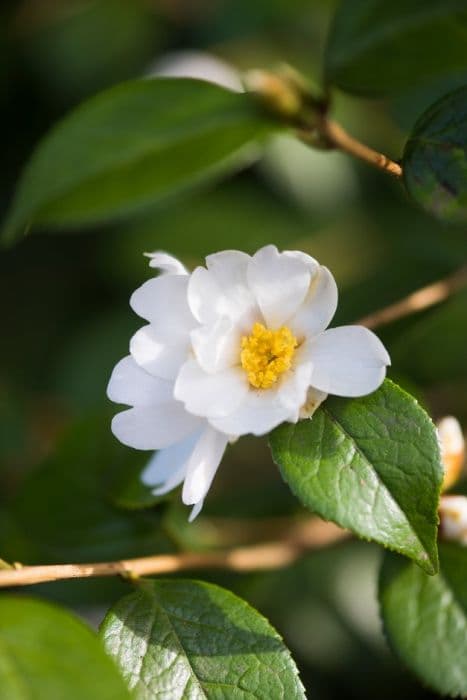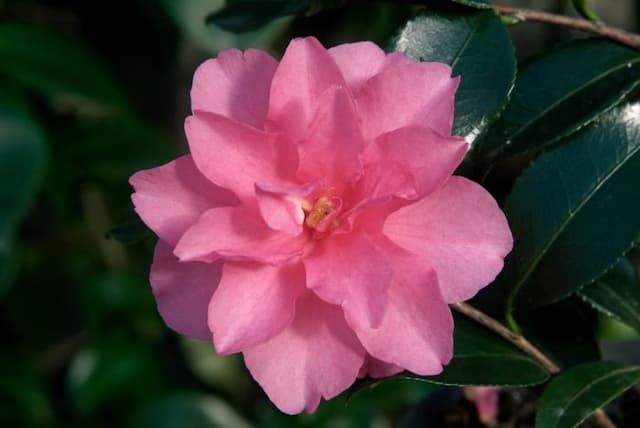Williamsii Camellia Camellia × williamsii 'Bowen Bryant'

ABOUT
The Camellia × williamsii 'Bowen Bryant', commonly known as the Williamsii Camellia, is a hybrid plant known for its attractive appearance. This variety features glossy, dark green leaves that provide a striking backdrop for its flowers. The leaves are typically ovate with a smooth, leathery texture, and they exhibit a slight serration along the edges. The most captivating aspect of the Williamsii Camellia is its blossoms. These flowers are usually large and showy, ranging from a soft pink to a deeper rose hue. Each flower consists of numerous petals that are delicately arranged in a formal double pattern, exuding an air of elegance and intricacy. The flowers emerge from round, plump buds that hint at the beauty to unfold. The Williamsii Camellia blooms during the cooler months of the year, often adding color to the garden when most other plants are dormant. Its blossoms not only enhance the visual appeal but can also attract pollinators, bringing life to the winter garden.
About this plant
 Names
NamesFamily
Theaceae.
Synonyms
Williamsii Camellia, Bowen Bryant Camellia.
Common names
Camellia × williamsii 'Bowen Bryant'.
 Toxicity
ToxicityTo humans
The Camellia, specifically the Camellia × williamsii 'Bowen Bryant', is generally considered non-toxic to humans. Ingesting parts of the plant is unlikely to cause severe poisoning. However, as with many plants, it is possible that some individuals might experience mild gastrointestinal discomfort if they consume leaves or flowers of the camellia.
To pets
The Camellia, including the Camellia × williamsii 'Bowen Bryant', is not commonly listed as toxic to pets such as dogs and cats. If a pet were to ingest parts of the camellia plant, it is unlikely to lead to significant poisoning. Nevertheless, it is always a good practice to prevent pets from eating plants, as individual sensitivities might vary, and consuming non-food items can potentially cause gastrointestinal upset.
 Characteristics
CharacteristicsLife cycle
Perennials
Foliage type
Evergreen
Color of leaves
Green
Flower color
Pink
Height
6-10 feet (1.8-3 meters)
Spread
6-10 feet (1.8-3 meters)
Plant type
Shrub
Hardiness zones
7
Native area
Asia
Benefits
 General Benefits
General Benefits- Ornamental Appeal: Camellia × williamsii 'Bowen Bryant', commonly known as Camellia, adds aesthetic value to gardens with its attractive blooms and evergreen foliage.
- Long Blooming Period: This hybrid often has a longer blooming season, providing flowers from fall to spring when few other plants are in bloom.
- Versatility in Landscaping: Suitable for a variety of garden designs, including formal, woodland, and Asian-inspired gardens.
- Low Maintenance: Once established, Camellias require minimal care beyond occasional pruning and watering during dry spells.
- Shade Tolerance: Camellias can thrive in partially shaded areas where other sun-loving plants might struggle.
- Attracts Pollinators: The flowers can attract bees and other pollinating insects, which are beneficial for the garden ecosystem.
- Drought Resistance: Mature plants can tolerate short periods of drought, making them relatively resilient in varying weather conditions.
- Privacy Screen: With its dense growth habit, Camellia can be used as an effective privacy screen or hedge.
 Medical Properties
Medical PropertiesThis plant is not used for medical purposes.
 Air-purifying Qualities
Air-purifying QualitiesThis plant is not specifically known for air purifying qualities.
 Other Uses
Other Uses- Crafting natural dyes: The petals of Camellia × williamsii can be used to create delicate natural dyes for fabrics or art projects, offering hues ranging from soft pinks to rich reds depending on the variety and processing.
- Floral arrangements: The blossoms of Camellia × williamsii are often used in floral arrangements due to their beauty and longevity, adding elegance and color to any bouquet.
- Culinary garnishing: Edible varieties of Camellia × williamsii flowers can be used to garnish salads, desserts, and drinks, providing an ornamental touch to dishes with their vibrant petals.
- Photography subjects: These flowers are popular subjects for photography enthusiasts due to their diverse colors and forms, offering captivating imagery for various artistic projects.
- Decorative candles: The petals of Camellia × williamsii can be embedded in candles to create decorative items that enhance the aesthetic of any room when lit.
- Botanical art: Artists may use the distinct shapes and colors of Camellia × williamsii as subjects for botanical illustrations and paintings.
- Pressed flower crafts: The blooms can be pressed and preserved to be used in scrapbooking, card making, and other paper crafts, adding natural beauty and texture to creative projects.
- Teaching tool: Camellia × williamsii can be used in educational settings to teach students about plant biology, hybridization, and the importance of plant biodiversity.
- Wedding decor: These flowers are often incorporated into wedding themes for bouquets, boutonnieres, centerpieces, and venue decorations, celebrating their romantic associations and diverse color palette.
- Soil improvement: When Camellia × williamsii leaves and flowers decompose, they contribute to soil enrichment by adding organic matter that enhances the soil's fertility and structure.
Interesting Facts
 Feng Shui
Feng ShuiThe Camellia is not used in Feng Shui practice.
 Zodiac Sign Compitability
Zodiac Sign CompitabilityThe Camellia is not used in astrology practice.
 Plant Symbolism
Plant Symbolism- Adoration: The Camellia flower is often associated with adoration and deep longing. Named for a beloved, 'Bowen Bryant' may carry this symbolism.
- Perfection: With its lush petals and flawless appearance, the Camellia represents the pursuit or attainment of perfection.
- Refinement: Camellias are symbolic of refined beauty and can signify someone's admirable perfection and elegance.
- Long-lasting loyalty: Camellias often signify loyalty that lasts through time, perhaps due to their own enduring blooms.
 Water
WaterThe Williamsii camellia should be watered thoroughly, allowing the top inch of soil to dry out between waterings. They prefer consistent moisture, which often means watering every 7-10 days, depending on the climate and weather conditions. The amount of water should be sufficient to soak the root area; approximately 1-2 gallons for small to medium-sized shrubs, adjusted based on the size of your plant and the drying rate of the soil. Over-watering or allowing the plant to sit in water may lead to root rot, so ensure proper drainage. It's important to water deeply and infrequently rather than little and often to encourage deep root growth.
 Light
LightWilliamsii camellias thrive in partial shade where they can receive filtered sunlight or morning sun followed by afternoon shade. Direct, harsh sunlight can burn their leaves and fade their flowers, so a spot that shields them from the intense afternoon rays is ideal. These conditions mimic their native environment beneath the forest canopy and promote healthy growth and beautiful blooms.
 Temperature
TemperatureWilliamsii camellias are hardy plants that can survive in temperatures ranging from 10 to 85 degrees Fahrenheit, but they prefer a temperate climate. The ideal temperature range for camellias is between 45 and 65 degrees Fahrenheit. They're resilient to brief cold snaps but should be protected from prolonged exposure to temperatures below the freezing mark, as this may cause damage to the plant.
 Pruning
PruningPruning Williamsii camellias is done to maintain their shape, remove dead or weak wood, and encourage robust new growth. The best time to prune is just after flowering ends in the spring but before new growth begins. Pruning can be done annually, adjusting to the plant's growth rate and desired size. Cut back to just above a set of leaves to promote bushier growth.
 Cleaning
CleaningAs needed
 Soil
SoilWilliamsii camellias require well-draining acidic soil with a pH of 5.5-6.5. A mix of 50% peat moss and 50% perlite or pine bark is ideal to ensure proper drainage and aeration.
 Repotting
RepottingWilliamsii camellias should be repotted every 2-3 years or when they outgrow their current container, usually in the spring before the growing season begins.
 Humidity & Misting
Humidity & MistingThe Williamsii camellia thrives at a humidity level of 50-60%. They benefit from being placed in a naturally humid environment or by using a humidifier.
 Suitable locations
Suitable locationsIndoor
Place in bright, indirect light and keep soil moist.
Outdoor
Partial shade, shelter from wind, and well-draining soil.
Hardiness zone
7-9 USDA
 Life cycle
Life cycleThe life of the Camellia 'Bowen Bryant' begins with germination, as seeds sown in well-drained, acidic soil sprout when temperatures are favorable, typically in spring. After germination, the seedling stage involves the development of the primary root and the emergence of cotyledons, followed by the first true leaves. As the plant enters the vegetative stage, it forms a woody stem and foliage, growing steadily and becoming bushier with glossy, evergreen leaves. The Camellia 'Bowen Bryant' reaches maturity within a few years, marked by the initiation of flowering, usually occurring in late winter to early spring, with pink or blush-colored, ornamental flowers. After the flowering period, pollinated flowers develop into seed pods that eventually dry and release seeds, completing the reproductive phase. Throughout its life cycle, the Camellia 'Bowen Bryant' may undergo cycles of growth and dormancy, especially in colder climates, and can live for many years, even decades, with proper care and favorable conditions.
 Propogation
PropogationPropogation time
Spring-Early Summer
Camellia × williamsii 'Bowen Bryant', commonly known as simply Camellia, is best propagated by semi-hardwood cuttings taken in late summer. The process involves selecting a healthy, semi-ripe stem that has just begun to harden after the current season's growth. Cuttings should be about 4 to 6 inches (10 to 15 centimeters) long, with several leaves left at the top. The cut end of the stem is then dipped into rooting hormone powder to encourage root growth and planted in a pot filled with a mixture of peat and perlite to provide adequate drainage and aeration. The pot is then covered with a plastic bag or placed in a propagator to maintain high humidity around the cutting, and kept in a warm, shaded place until roots develop, which usually takes several weeks to a few months. Regular monitoring is necessary to ensure the soil remains moist but not waterlogged, and to prevent mold or fungal infections. Once rooted, the cuttings can be transplanted into individual pots and eventually into the garden.









